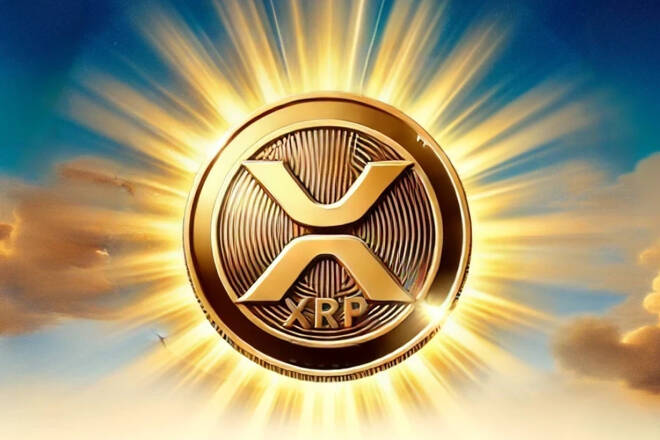Advertisement
Advertisement
XRP News Today: XRP Depository Receipts to Boost Demand—Are ETFs Next? BTC at $96K
By:
Key Points:
- XRP Depository Receipts to launch, giving accredited investors indirect XRP exposure without using crypto exchanges.
- SEC’s decision on XRP-spot ETFs could drive massive demand—will regulatory approval reshape XRP’s future?
- Institutional investors remain bullish on XRP, but retail sentiment is at historic lows. Can ETFs change the narrative?
XRP Depository Receipts to Boost Demand
On Friday, February 7, Fox business journalist Eleanor Terrett reported that accredited investors will soon be able to purchase XRP depository receipts (DR). XRP DRs will reportedly be available through Receipts Depo and DWP Advisors.
Terrett likened Deposit Receipts to Exchange Traded Funds, explaining:
“The XRP DR represents ownership of the underlying $XRP without investors having to buy the asset directly via a crypto exchange. The benefits are similar to those of an ETF where investors can gain exposure to an asset without having to buy it directly through a foreign exchange or a crypto exchange.”
Are US XRP-Spot ETFs Next?
The latest development comes amid ongoing speculation about SEC approval for US XRP-spot ETFs. On Thursday, February 6, the Chicago Board Options Exchange (CBOE) submitted 19b-4 applications to the SEC. The filings sought approval for Bitwise, 21Shares, Canary Funds, and WisdomTree XRP-spot ETFs.
As with previous crypto-spot ETF filings, the SEC has 45 days to review the applications but may extend the review period to 90 days.
The launch of a US XRP-spot ETF market, combined with the availability of XRP DRs, could boost XRP demand. However, Bitwise Invest Chief Investment Officer highlighted a disconnect between retail and institutional investor sentiment, stating:
“There is an absolutely massive disconnect between retail and professional sentiment in crypto right now. Retail sentiment is the worst it’s been in years, while professional investors are extraordinarily bullish. It’s like living in two completely separate worlds.”
While Trump’s re-election initially boosted sentiment, his subsequent tariff policy pressured XRP prices. XRP has fallen from $3.1341 to February 3 low of $1.7938 on tariff jitters before partially recovering. US tariffs may drive import prices and inflation higher, potentially leading to a more hawkish Fed rate stance.
Institutional demand could be vital in restoring retail confidence and supporting a return to the $3 level.
XRP Price Trends: SEC Appeal Uncertainty Lingers
On Friday, February 7, XRP advanced by 3.11%, reversing Thursday’s 2.34% loss to close at $2.3260. XRP outperformed the broader crypto market, which slipped by 0.06% to a total market cap of $3.9 trillion.
Hopes for an XRP-spot ETF market and XRP DRs drove buyer demand. However, uncertainty about the SEC’s appeal plans remains an XRP headwind.
Developments in the Ripple case remain the key driver for XRP since the agency may decline the spot ETF applications if it plans to pursue the appeal.
- If the SEC withdraws its appeal, XRP could rally past its all-time high of $3.5505.
- If the appeal proceeds, XRP may drop below $1.50.
Expert Analysis: How will the SEC’s next move shape XRP’s future? Read more here.
BTC Tumbles as US Inflation Expectations Rise
While investors monitored the Ripple case, the Michigan Consumer Sentiment Report overshadowed upbeat US labor market data.
The US unemployment rate unexpectedly fell to 4.0% in January, down from 4.1% in December, while average hourly earnings rose 4.1% year-on-year (December 4.1%). BTC reacted positively to the US Jobs Report, rallying to a session high of $100,216.
However, the Michigan Inflation Expectations Index surged from 3.3% in January to 4.3% in February. Consumers could increase spending if they expect prices to rise higher in the future, leading to demand-driven inflation. In response, BTC tumbled from $100,216 to a low of $95,688.
US BTC-Spot ETF Market Inflows Counter Inflation Impact
Despite inflation concerns, the US BTC-spot ETF market provided much-needed support. Farside Investors reported the following net inflows on February 7:
- ARK 21Shares Bitcoin ETF (ARKB): $59 million
- Fidelity Wise Origin Bitcoin Fund (FBTC): $52.5 million.
- iShares Bitcoin Trust (IBIT): $21.9 million.
The US BTC-spot ETF market recorded $171.3 million in net inflows. Progress toward a US Strategic Bitcoin Reserve (SBR) likely boosted demand for BTC through spot ETFs. On February 6, news broke of the House in the US state of Utah passing a Strategic Bitcoin Reserve Bill.
Bitcoin Price Outlook
On Friday, February 7, BTC edged 0.01% lower after Thursday’s 0.03% slip, closing at $96,635.
BTC’s near-term price trends hinge on several key factors, including US-China trade-related news, SBR-related news, the Fed rate path, and US BTC-spot ETF flows.
Possible Scenarios:
- Bearish case: Heightened US-China tensions, a hawkish Fed, and stalled SBR discussions could drag BTC below $90,000.
- Bullish case: Improved US-China relations, dovish Fed signals, and SBR progress could push BTC toward its all-time high of $109,312.
Market Outlook: Regulatory Developments in Focus
After Friday’s mixed session, investors should monitor two key developments:
- SEC’s decision on the Ripple case appeal.
- Progress toward a US Bitcoin Reserve.
Both factors could significantly influence institutional adoption and overall crypto market sentiment.
Stay updated with our expert analysis of these developments and their implications for crypto markets. Explore the full analysis here.
About the Author
Bob Masonauthor
With over 28 years of experience in the financial industry, Bob has worked with various global rating agencies and multinational banks. Currently he is covering currencies, commodities, alternative asset classes and global equities, focusing mostly on European and Asian markets.
Did you find this article useful?
Latest news and analysis
Advertisement
